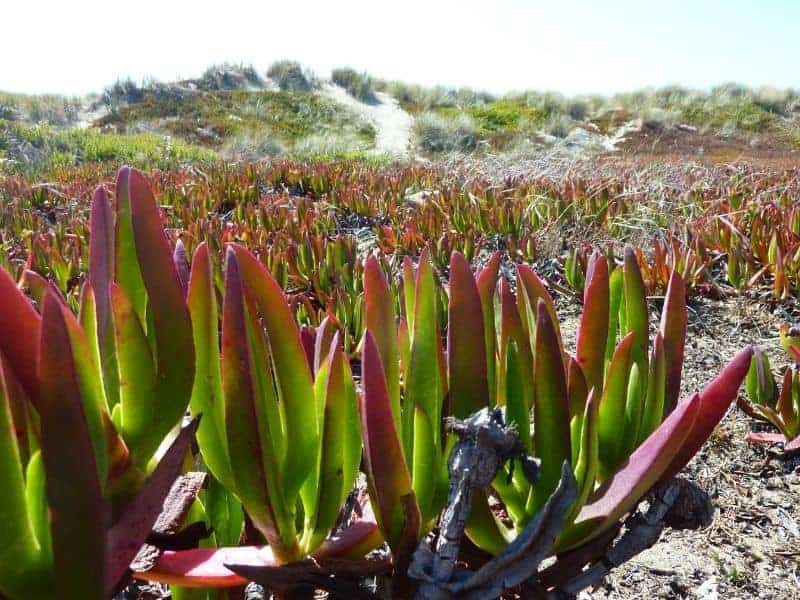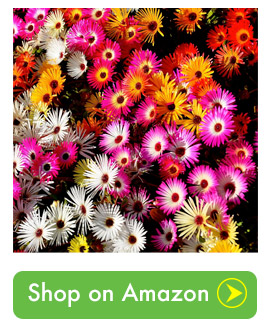If you’re looking for a drought tolerant but lovely flower to fill in your dry, troubled areas of the garden, ice plants might be just what you need. These bright flowers are easy to care-for and have an adorable name too! Keep reading about these pretty plants and how they can help take care of those troublesome spots that don’t get enough water.
How do you take care of an ice plant?
This hardy succulent is a perennial groundcover plant with vibrant blooms and drought-resistance. Ice plants are tolerant in USDA plant hardiness zones 5 to 9, but grow well in parts of the United States that have milder climates like Illinois and Ohio.
Ice plants require very little care other than occasional water once established. These drought resistant succulents need only enough rainfall or irrigation to keep the soil moist for short periods of time. Sandy, gravely soils commonly used in succulent potting mixes work best for growing the ice plant.
The ice plant is a tough little succulent that thrives in drought conditions, so green thumbs are not 100% necessary here. When establishing an ice plant, ensure the soil is sandy and well-drained with a good drip pan to keep it alive during dry spells.
Do ice plants come back every year?
That really depends on the climate you are growing in, unless you plan to keep them indoors. Don’t let the name fool you, this isn’t called the ice plant because of some super-resistance to frost! Many cultivars won’t do well past zone 6.
Having said that, if they are planted in the correct zone, ice plants should act as perennials in the garden. You can even grow them from seeds easily in most climates and there are plenty of wildflower seed mix options online that include several different varieties of the ice plant for a colorful garden arrangement.
Click the Image Below – Buy Ice Plant Wildflower Seed Mix Online
Do Ice plants need full sun?
They do tend to prefer it, but some varieties are okay in partial shade. If planting it in an area that is mostly shady, ensure you water the ice plant at least once a week.
If your ice plants are struggling to grow or maintain their color, they may need more sun than you can provide them in the current landscape.
Try moving them to another part of the garden where there’s more light available and see if this remedies the situation.
Do ice plants need deadheading?
Not necessarily, but you may consider it a good practice to keep your garden looking its best. In this case, deadheading does not seem to be a necessity.
If you do choose to deadhead your ice plants, chop and drop! It may help with potentially reducing weed growth near the plant since it decreases sunlight exposure on these usually sunny areas of your garden. You can also save a few cuttings if you want since most species will develop roots in a container of succulent soil mix within a few weeks.
Light, Soil, Water, Temperature and Humidity Requirements
The Ice Plant thrives in certain conditions. They prefer sun exposure, but not too much. They also like to be watered often and their soil should be kept fully drained. Their temperatures are cool or cold tolerant with a average of 20 degrees Fahrenheit in the winter months to 40-60 degrees Fahrenheit during the summer season.
Their humidity requirements are low which is ideal for arid climates such as Phoenix Arizona’s desert climate where many varieties can grow outside year round without any difficulty at all. Ice plants thrive indoors too if given bright light sources and plenty of warm water, since these conditions mimic those found outdoors naturally. Be sure to use a sandy, rocky soil that’s made specifically for succulents.
The Best Fertilizer for Ice Plant Care
You’ll find that growing your ice plant successfully doesn’t require a lot of added soil amendments and fertilizers. In fact, it’s recommended you dilute an organic liquid fertilizer like Bush Doctor Flower Kiss 1.0-0.30-0.05 with double the amount of water advised on the packaging. This way, you can apply it to the soil at one of your regular waterings or even add to a spray bottle for a foliar feeding (where you spray fertilizer directly on the leaves). However you choose to apply it, know that you want to order the smaller size if it’s available because you only need to fertilize your ice plant once in the fall every year.
Varieties of Ice Plants
There are many different types of ice plants that thrive in different climates and have different flowers. Ice plant varieties can grow to be one foot tall or as high as three feet, depending on the type of ice plant.
- Lampranthus – The most common variety is a drought tolerant, cold hardy succulent with green leaves and red stems. It has bright purple shaped blooms which are very fragrant and cover its foliage during the late winter months or from late summer into fall in some cooler climates. This is an easy care variety for people who don’t want too much upkeep but still enjoy seeing colorful blossoming flowers every so often throughout their gardens.
- Delosperma brunnthaleri is a very low growing ice plant variety that’s native to South Africa This type of ice plant is often grown in containers and works well as a ground cover. It has bright vibrant flowers that bloom during the spring months but will also produce new foliage if it gets enough water after flowering.
- Delosperma cooperi – Though this variety is not quite as cold hardy or drought tolerant as Lampranthus, Delosperma cooperi does have bright colors with yellow-orange blossoms that grow to be about four inches wide. The flower color ranges from reds to oranges depending on what time of year they are blooming. These plants can stay green all winter long in colder climates which makes them a good choice for gardeners who don’t want exposed soil to erode away with winter rains.
Diseases and Pests That Harm Ice Plants
The primary two pest concerns with Ice Plants are mealybugs and aphids, the latter of which can occasionally lead to an ant infestation. If that happens, check out our comprehensive guide on how to deal with ants organically. There’s plenty of organic pest control options out there to help you care for your ice plant.
In the case of mealybugs, they secrete a sticky substance called honeydew which can cause sooty mold and attract ants. Aphids also excrete their own sweet honeydew but it is usually not as bad an issue for ice plants because aphids are more commonly found on new growths that have not leafed out yet.
The only disease I know of about Ice Plants is downy mildew. This fungus typically occurs after frost damage has already occurred. This means preventive measures like good air circulation and spacing between plants will help, but it’s a late season problem that’s typically not too serious if you limit irrigation going into the winter.
Where to Buy Ice Plants Online?
If you want to grow ice plants, you can easily source live plants online. Click here to find the plant that best suites you.



